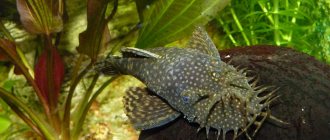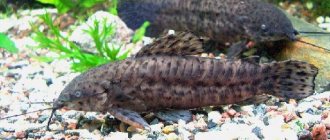How do catfish reproduce?
Ancistrus can be easily propagated at home. To reproduce, you need sexually mature fish, at least one male and one female. Catfish can spawn in a spawning tank with a volume of 80-100 liters. The larger the volume of the tank, the more offspring will appear, and the more comfortable the fish will be. In addition to space, the perimeter of the aquarium is important. It is advisable to choose a low container with a wide bottom area. You can put dark cardboard under the bottom glass, or pour a little sand or gravel on the bottom.
A small amount of soil substrate will simplify the care of breeders and fry. For filtration, you can choose a powerful pump covered with protective foam. Lighting is recommended not to be very bright. Some species of ancistrus (Ancistrus dolichopterus, A. Triradiatus) breed in soft water, so it will need to be softened with reverse osmosis water.
Quickly navigate to the article
Preparing for spawning
Two females and one male can be placed in a spawning tank with a volume of 80-100 liters. The larger spawning area can accommodate four females and two males. In a general aquarium, the ratio of producers is similar. In a cramped aquarium, two males will compete for the attention of females, so they usually do not spawn. It is necessary to choose sires of the same body size; the female may be slightly larger. Active males may kill a female that is too small in size.
Ancistrus catfish prefer to spawn in PVC pipes, although the spawning process is also possible in other substrates - clay pots, coconut shells, or wood snags. You can install one or two PVC pipes for spawning. You can place several pieces of treated wood in the aquarium. The water temperature in the aquarium should be at the level of 24-27 o C, the permissible acidity of the water is 6.5-7.5 pH. It is important to maintain cleanliness in the spawning aquarium - once a week you need to replace half of the water with clean and infused water, or 2 times a week for 25% of its volume.
Watch a video with tips on breeding ancistrus.
Feeding producers should be varied - fresh vegetables (pumpkin, cucumbers, zucchini, green beans) should be fed. Several times a week it is allowed to give live or frozen meat food (bloodworms, shrimp meat). Ancistrus eat well tablets with spirulina, or branded granules for plecostomus catfish.
Ancistrus spawning
Ancistrus catfish can spawn for a long time - from a week to a month. The timing of reproduction depends on the conditions of keeping the fish and their readiness for the process. The first signs of readiness for reproduction are shown by the male - he swims into the pipe and actively spreads his fins. The male also takes care of the eggs - he will provide the eggs with everything they need, however, under severe stress, the male can eat the clutch. It is advisable to move the clutch with eggs to another place, this will make it easier to sort the grown fry. You need to place the eggs in a mesh cage, which needs to be placed in the spawning tank. On top you need to install an aerator with a spray (4-6 cm higher than the eggs). With proper care, the masonry will not become infected with fungus or other ailments.
The clutch is yellow-orange in color, with a total of 30 to 100 eggs. Incubation lasts 5 days, and depends on the water temperature. If the clutch was guarded by a male, then after the incubation period, he will guard the fry for another day, and then will leave the pipe in search of food. If a male spawned with several females, then he can guard all their clutches. If you move the clutch with larvae too early, the male will be very stressed.
See how the artificial incubation of ancitrus eggs occurs.
How to raise fry?
After 1-2 days, the ancistrus fry will begin to swim freely in the aquarium, looking for food. Fresh vegetables and dry catfish food can serve as starter food. For the first 24-48 hours, the fry are unlikely to accept vegetables, but later they will get used to them and will perceive them as food. Ancistrus babies are quite large, so you can prepare a separate tank with a volume of 80-100 liters for them. A new house should have a filtration system and heating. Every day you need to change 20% of the water in this container. In a month it will be clear that some fry are larger than their counterparts.
To avoid cases of some fry being eaten by others, they need to be sorted and placed in different containers. If there are 50 fish or more in the brood, then sooner or later you will need another container. Later, they can be given branded catfish food, protein-rich food.
Ancistrus breeding in a community aquarium
Material 1997, 2013-2014 (previously not published)
Breeding dolichopterus (Bristlenose Plecostomus)
lately is not something supernatural. Catfish successfully spawn, often even in common aquariums for beginners.
However, most often (especially in a community aquarium) it is impossible to predict or control spawning. And in this case, you also need to be able to preserve offspring.
Experienced hobbyists, as a rule, breed catfish in a separate container, recreating the conditions necessary for successful breeding.
ancistrus reproduce , including in my publications . I will not dwell on the classical method of breeding, especially since this common technique has a number of significant disadvantages:
- Fish placed in a spawning area from familiar conditions are forced to undergo a period of acclimatization in new conditions. Therefore, the aquarist must consider the time involved when planning the reproduction of his pets.
- In addition to setting up a holding aquarium and a rearing aquarium for the resulting fry, a third tank is needed. This is actually a spawning ground, which allows you to create and control the conditions necessary specifically for the reproduction of fish. The spawning tank and the nursery are, as a rule, two different containers, since ideally, different conditions are needed for breeding and for the successful rearing of fry. Therefore, here (in addition to the need to contain an additional jar) there is another disadvantage. This is the need to transplant juveniles (or eggs) and the associated risks.
- One of the conditions necessary for successful spawning is the presence of a shelter in which the male makes a nest. But the very presence of a shelter practically eliminates the possibility of control and, in general, any participation on the part of the person who (thinks that he) breeds ancistrus.
In fact, in most cases, the owner of the fish is only a statist, and confirmation of success for him is often the appearance of larvae or fry from the shelter. And this is sometimes 10 days after spawning. When exactly spawning occurred, how many eggs died during incubation and for what reasons, the aquarist most often does not see. And there is no talk at all about intervening in the process if the masonry is threatened.
Description
The body of Ancistrus is elongated, teardrop-flattened, covered with bone plates, the head is wide. The mouth is in the shape of a suction cup with peculiar horn-like scrapers, with which the ancistrus scrapes off plaque from snags, leaves and the walls of the aquarium.
The dorsal fin is large, flag-shaped and, in some individuals, pressed to the back. The adipose fin is small, and the ventral and pectoral fins are wide and large.
The color ranges from a yellowish-gray tint to dark gray and even black, the whole body is dotted with light spots. The abdomen is slightly lighter. Juveniles are distinguished by a bluish body color and white edging on the anal and dorsal fins.
A male can be distinguished from a female by the presence of tentacles - leathery processes located on the head, which are absent or almost invisible in females. Males are slimmer and larger and can grow up to 13 cm.
Ancistrus stellata
The birthplace of this species is the great Amazon River. This catfish has a dark brown or black color. Large white specks gradually become brown over time, while the white frame of the fins transforms into small pale dots with a frame of a dark shade. Females are larger and lighter than males. At 10 months, males begin to develop skin growths on their faces.
We suggest you read: Names of aquarium fish, choosing pets for the aquarium
This representative of catfish is home to the Amazon. It has a dark brown or black color. Large white specks gradually become brown, and the white border of the fins on the back forms pale small dots with a frame of dark shades. Females are larger and lighter than males. Males begin to develop leathery growths on their faces at the age of 10 months.
Aquarium arrangement and maintenance
Ancistrus simplex is quite unpretentious and can be kept in any type of freshwater aquarium with a minimum volume of 50 liters. A mandatory maintenance condition is the presence of numerous caves, snags and stones, which serve as a shelter and resting place for the fish. Basically, the male ancistrus chooses one cave he likes and stays close to it, keeping other fish away. Large stones must be stable and lie at the bottom, otherwise the ancistrus may crawl under the stone, which will crush it.
The outlet tubes of the filter should be closed for safety reasons, since the ancistrus, which loves strong currents, can swim too close to them, get into the filter and die.
Ancistrus easily tolerate temperature fluctuations within 17-30°C, but the most comfortable temperature is 22-25°C. РH – 6.5-7.5, dGH – about 15°.
In nature, Ancistrus vulgaris prefers fast-flowing, oxygenated waters, so the aquarium requires powerful filtration with aeration. Partial water changes should be done regularly.
Ancistrus does not like bright light, but due to the fact that it is necessary for plant growth, it is necessary to ensure alternation of light and dark phases with intermediate twilight lighting.
The common ancistrus is very peaceful and can be kept with any fish with similar conditions.
Opinions are like bones - everyone has their own
The body of the catfish is elongated, flat with a wide head, and can reach 10 cm in length. The color of Ancistrus is dark with small light inclusions. The sticky mouth has the appearance of a suction cup, consisting of horn-like processes that help Ancistrus attach to the walls of the aquarium and stones.
It is quite simple to distinguish a male from a female: the entire muzzle of the male is covered with leathery processes. In addition, males are slimmer than females.
In a home aquarium, the Ancistrus catfish is an indispensable assistant - it happily destroys algae, because needs large amounts of food throughout the day. So, the catfish is always full and happy, and the walls in your aquarium remain clean and transparent for a long time!
Maintenance and care at home
Because The catfish reaches quite large sizes - 10-15 cm - and by its nature Ancistrus is a rather mobile and active fish; the volume of the aquarium should be at least 80 liters. In addition, Ancistrus loves to hide, so various driftwood, bridges, and decorations should be placed in the aquarium. The entire way of life of Antsitsrus comes down to searching for food. Since it eats a lot and often, it produces waste products in large quantities. This must be taken into account, because in such conditions, water changes are required at least once a week.
The optimal water temperature is 22-26 degrees, intensive aeration is desirable.
Ancistrus is a nocturnal fish, so it is most active in the evening.
When it comes to food, Ancitrus prefers special food for catfish in the form of tablets of plant origin, and also likes cucumbers and lettuce, which must be scalded with boiling water before feeding. During the spawning period, to improve the performance of Ancistrus, it is necessary to feed it with frozen food.
Compatibility with other fish
Ancistrus is very peaceful and calm; Ancistrus can be kept together with almost all types of aquarium fish: they get along well with angelfish, swordtails, cockroaches and even bully barbs. Of course, it is undesirable to keep Ancistrus with aggressive individuals, large cichlids.
Breeding Ancistrus
Breeding ancistrus at home is not particularly difficult. Sometimes it can take place without special control in a common aquarium. With targeted breeding, a male and a female are placed in a separate aquarium - a spawning tank. If the spawning ground is large, then you can plant one male and two females. For successful spawning it is necessary to carry out frequent water changes and abundant feeding. The water temperature during spawning is increased by 2-5 degrees.
It is necessary to place a tube-shaped shelter in the spawning tank - only there the female will lay eggs. The number of eggs can be 30-100. After spawning, only the male takes care of the future offspring: he drives the female out and fans the eggs with his fins, providing them with oxygen.
Within 5 days, small larvae emerge from the eggs, which the male continues to care for for another couple of days. They do not move - they hang motionless in the water. There is no need to feed them: at first they feed on their own reserves of the yolk bladder. After the supplies have expired - after about a couple of days - the fry begin to be fed with crushed tablets or even crushed cucumbers. The main thing is to provide the fry with full access to food.
Thus, keeping and breeding Ancistrus is not difficult. Therefore, start, breed and rejoice! :)
Nutrition
In nature and in aquarium conditions, the favorite food of the common ancistrus is the plaque that forms on driftwood, stones and glass, especially if the aquarium is well lit. In addition, it eats the remains of plant and live food that are not eaten by other fish. When there is a lack of algal growths, it switches to plant leaves, especially young ones, leaving holes on them.
To avoid damage to plants, it is necessary to feed the ancistrus with plant foods: leaves of cabbage, lettuce and nettle scalded with boiling water.
Catfish stuck: reproduction
None. At all. If the aquarium is correct, then you need to introduce catfish and forget that they are there. Get it out of your head. I had a 400 liter aquarium “mothballed” at the service. Aquarium with live plants and three plecostomus. I didn’t feed them at all for half a year. From the word absolutely. There are tablets for catfish in the store, but they do more harm than good.
What to do when there are a lot of catfish or they are divorced? You can feed it. They eat everything: from fish corpses to cucumbers and pumpkin. For us, the best option is large sinking fish food. Just a request - don't buy a cheap one.
Experts identify several types of catfish, each of them having its own characteristic features. Let's look at them in the article below.
Representatives of all Ancitrus species have the same reproduction pattern. They lay their eggs in various crevices: behind the filter, between stones, etc. Males guard the clusters of eggs from females until the larvae hatch. Within six months, the fry turn into adult full-fledged catfish.
Reproduction
Doesn't present any particular difficulties. Often, fish are able to lay eggs in a community aquarium, but then the risk of death of the fry is high. The female lays eggs in a secluded place, sometimes even behind or in the filter.
Parental care is mainly provided by the male. From the moment the large orange eggs appear, he fans the eggs with his fins, regularly cleans them with his mouth and protects them from all kinds of enemies, even from the female.
For breeding, it is better to use a separate spawning tank with a volume of 50 liters or more, placing bamboo or ceramic tubes, stones, driftwood, and small clay pots there. To stimulate spawning, water is replaced by a third during a decrease in atmospheric pressure.
Water parameters for dilution: 20-26°C, pH 6-7.3, KH 2°, dH 10°.
The female's readiness for spawning is determined by her rounded abdomen. In some cases, spawning occurs the next day, but generally the male selects a suitable shelter over the course of several days and cleans it thoroughly. During this period, the diet should consist mainly of plant foods. The female usually spawns at night. The number of eggs can vary from 20 to 300 pieces and depends on its size and age. During the first spawning, the amount of eggs is usually minimal.
The female glues the eggs in the form of a large cluster in a place prepared by the male, and this is where her responsibilities for raising offspring end. She sits down, otherwise the male, protecting the eggs, can seriously harm her.
During the period of egg development, which lasts from 4 days to a week depending on the temperature, the male does not leave the eggs even to eat.
If spawning occurs in a common reservoir, the male should be immediately placed in the spawning tank along with the eggs, but only if the female has secured them in some kind of tube or grotto. If the eggs are laid on the glass, they should be carefully removed with a blade, but in this case the male does not need to be transplanted. Having suffered such stress, he will refuse to care for the eggs and may even eat them.
Ancistrus larvae are quite large with large yolk sacs. At first, they remain hanging in a bunch, and only after a few days they gradually spread throughout the aquarium. At this stage, the male leaves and the fry can be fed. Special food for fry and tablets intended for catfish are suitable as starter food. The fry stick to them and slowly chew them off. Finely ground plant food is also suitable.
Ancistrus fry grow very quickly. Feeding should occur at least three times a day, and water should be changed daily by approximately 20%.
At six months, the fry practically catches up with the size of their parents, and by 8-12 months they reach sexual maturity.
Feeding
The diet of ancistrus should mainly consist of plant foods. Dry flakes and catfish tablets with spirulina are perfect for these purposes. It is better to throw the tablets into the aquarium in the dark, after turning off the lights. In this case, the catfish are guaranteed to get food. Frozen bloodworms, shrimp, brine shrimp and others are suitable as a source of protein food.
Ancistrus veilata
Ancistrus golden blue-eyed










